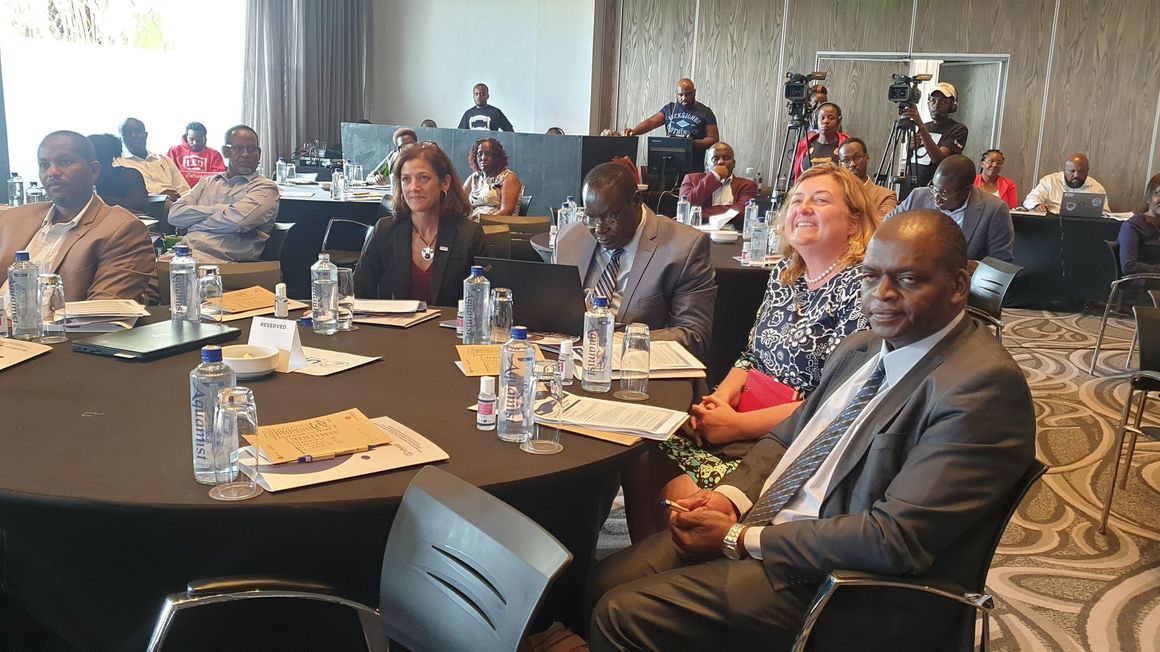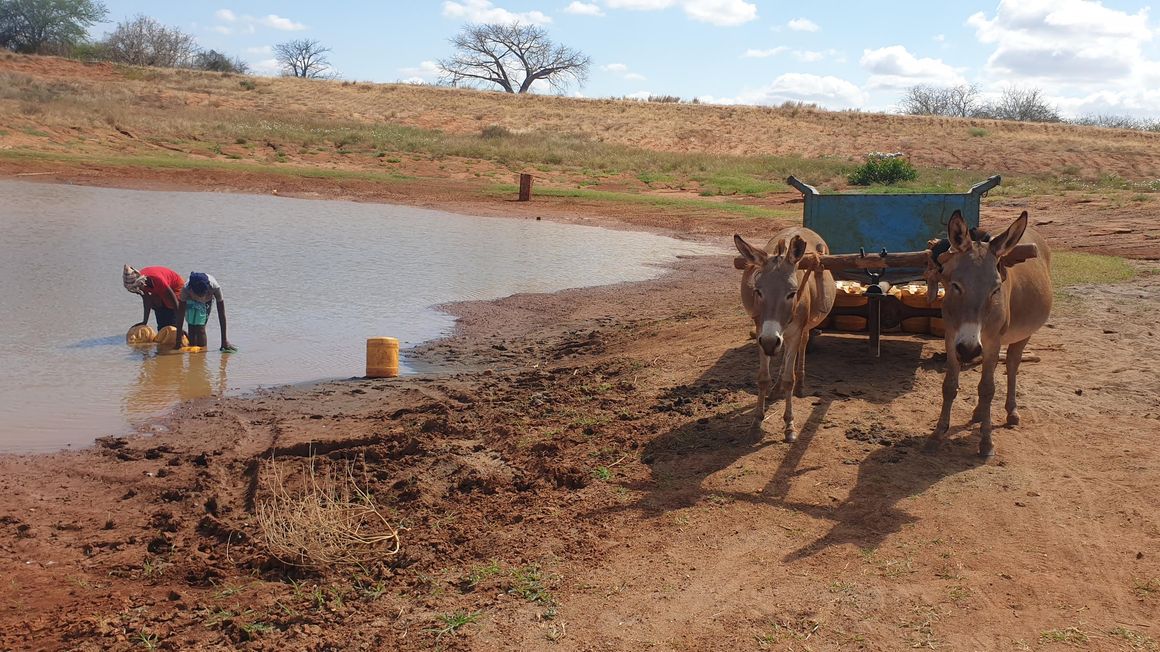
USAID Kenya and East Africa Deputy Mission Director Sheila Roquette speaks at Trade Mark Hotel in Nairobi during the HoRN learning event. She called for the adoption of a joint implementation approach to build resilience in the fights against climate change. PHOTO | RACHEL KIBUI | NMG

Development organisations predict that up to 5 billion people will face water shortages by 2050 globally as the climate change bug continues to bite and the effects intensify.
The Horn of Africa region is already highly affected by climate change and is facing the worst drought ever experienced in the last four decades.
Besides the impacts of climate change, other significant trends and issues affect the continent, including rapid population growth, with urbanisation rates expected to triple by 2050.
In a hybrid meeting held both physically and via zoom at Nairobi’s Trade Mark Hotel, stakeholders deliberated on how to deal with development issues in the Horn of Africa, especially regarding climate change and its effects.
The gathering was the second to be held this year and for the third time in history. Dubbed the Horn of Africa Resilience Network (HoRN) learning event, the annual event brings together stakeholders, including representatives from both national and regional governments, development partners and private sector actors. Other participants include the United States Agency for International Development (USAID) bilateral mission representatives and academic and research institutions.
Stakeholders follow proceedings during the HoRN learning event in Nairobi On October 26, 2022. Dr James Nyoro, an agricultural economist and food security expert from kenya, outlined some gains made in g climate change adaptation in the past few years. PHOTO | RACHEL KIBUI | NMG
Knowledge sharing
The HoRN acts as a platform for interaction and knowledge sharing among stakeholders. It is also an opportunity for creating partnerships through engaging in effective multi-stakeholder partnerships to leverage the comparative advantages critical to making developing countries and communities more resilient and self-sufficient. During the forum, participants also explore discussions around the future of resilience in the Horn region.
On October 26, participants at the HoRN learning event discussed climate change, its effects, the future, resilience and the development agenda, among other related subjects. Under the theme ‘Climate change adaptation and resilience: Managing risks for a more resilient future’, the half-day event brought to light various issues through cultural lenses, livelihoods, economies, health and access to fundamental rights that affect local communities in the region.
Climate shocks and stresses
“Everyone around the globe is vulnerable to climate change. Even though other countries are more vulnerable, climate shocks and stresses are increasingly impacting all of us,” said Laurie Ashley, the Resilience and Climate Adaptation Advisor-Centre for Resilience at USAID.
She noted that most impacts of climate change are related to water— too much of which results in flooding and too little of which results in drought — as is the current situation in many places within the HoRN region.
Climate change has threatened development progress and exacerbated inequality, including increasing water and food scarcity, the need for humanitarian assistance and displacement.
USAID, Ms Ashley noted, has developed a new climate change strategy for 2022-2030 with six ambitious targets that sustain the gains already made in building resilience in the face of climate change-related shocks and stresses.
The strategy is built on the understanding that without urgent action, climate change could push an additional 100 million people into poverty by 2030. The strategy’s targets include adaptation, which will improve the climate resilience of 500 million people, and finance, through which USAID will mobilise $150 billion in public and private finance for the climate agenda.
Residents of Mtito Adei in Kenya’s Makueni County fetching water from a dam. The Horn of Africa region is already highly affected by climate change and is facing the worst drought ever experienced in the last four decades. PHOTO | RACHEL KIBUI | NMG
Reduce carbon emissions
Under the mitigation target, USAID will collaborate with countries to support activities that reduce, avoid, or sequester an equivalent of six billion metric tonnes of carbon dioxide. Through the Natural and Managed Ecosystems target, there will be support for the conservation, restoration, or management of 100 million hectares, with a climate change mitigation benefit. Under the Critical Populations target, USAID will support its partners to achieve systemic changes that increase meaningful participation and active leadership in climate action for indigenous people, local communities, women, youth, and other marginalised and underrepresented groups in at least 40 partner countries.
“Achieving these targets will require a holistic approach — every USAID sector, mission, and the programme has a role to play as we work towards more resilient systems in areas like agriculture, energy, governance, infrastructure, and health,” said Ms Ashley.
“With all hands on deck and using locally-led and equitable approaches, we will greatly increase our ability to address current and evolving climate risks,” she added.
In her opening remarks, USAID Kenya and East Africa Deputy Mission Director Sheila Roquette called for the adoption of a joint implementation approach, saying it would yield the maximum results needed to ensure communities become resilient and interventions lead to desired results.
“Only together can we achieve resilient systems guided by national and regional priorities. There is a need for greater and strengthened regional and cross-border collaboration to advance resilience in the region,” said Ms Roquette.
Climate change adaptation
In his presentation, Dr James Nyoro, former governor of Kenya’s Kiambu County, who is also an agricultural economist and food security expert, outlined some gains made regarding climate change adaptation in the past few years.
Significant policies and strategies have been formulated in Kenya, which include the National Climate Action Plan 2008/2022, National Climate Change Response Strategy 2010, the National Disaster Management Authority strategic plan, and Vision 2030 for the development Strategy for Northern Kenya and other Arid Lands.
Regarding climate mitigation, several approaches have been adopted. They include enhancing the use of green energy in Kenya by up to 85 per cent, enhancing reforestation and afforestation (the current government proposes to have every citizen plant at least three trees over the next five years), enhancing efficient energy utilisation methods and popularising the use of renewable energy in rural areas.
Dr Nyoro stressed the need to ensure the engagement of community members across the board. In addition, there is a need to employ measures that focus on climate change adaptation. Such measures include promoting climate-smart agriculture and sustainable, regenerative and conservative tillage, enhancing capital-intensive precision agriculture, solarising streets and water sources, enhancing drought and flood management and developing more early maturing drought-resistant crops.




No comments :
Post a Comment